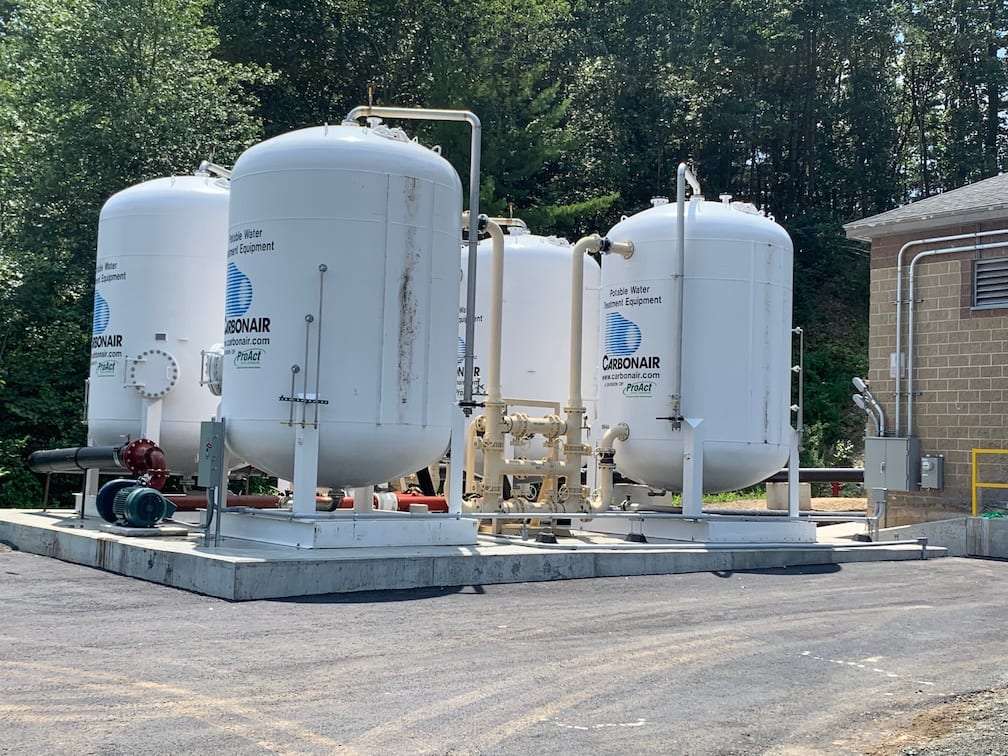Water District Priming for Flush of Money
- April 19th 2024
- City News

The Sanford Water District is exploring installation of an ion exchange water filtration technology, a more compact version of this treatment plant in Hudson Mass.
Photo: Massachusetts Municipal Association
Lee Burnett, Submissions Editor
Sanford Water District had anticipated last week’s announcement of tougher federal drinking water standards and is already deeply involved in developing costly new filtration systems.
“Ninety nine percent of it was expected. It wasn’t a surprise,” said Superintendent David Parent.
The standards announced by the Environmental Protection Agency ratchet sharply downward the allowable limits for PFAS, a huge class of menacing chemicals that have been leaching into the environment for decades. Sanford Water District has nine wells scattered across the city. The district shut down one well last September, immediately upon learning the well had flunked testing under the laxer standards. Three more wells are now in the cross hairs due to tougher standards and will be included in the treatment plan, according to Parent.
“We were told if you’re detecting PFAS, you should be treating. That’s what we’re going to do,” he said. “We’re not going to play games.”
The district’s quick action last fall is drawing respectful comment from one environmental watchdog group.
“It’s great to see Sanford being so responsive in containing the problem last fall,” said Dana Colihan, co-executive director of Slingshot, the Maine-based environmental advocacy group that staged the EPA press conference when standards were announced. “We hope to see them act swiftly in implementing these [treatment measures].”
The district has already been awarded $262 million from Maine’s Drinking Water program, which Parent said will be sufficient to design two new filtration systems. A combined filtration system will be installed to serve so-called Cobb 1 and Cobb 2 off River Street and a separate combined filtration system will be installed to serve Eagle 1 and Eagle 2 in the industrial park, he said. Both will probably use ion exchange technology, which acts like a magnet for contaminants, according to Parent. Ion exchange, also called resin beds, is an emerging and more expensive option than granulated activated carbon (GAC).
The district has also been awarded $4 million from the Drinking Water State Revolving Fund toward the construction of one filter bed, though the combined cost of both beds could be in the $12-$15 million range, Parent said. Other funds could be forthcoming from a class action suit and from the additional awards from the Drinking Water State Revolving Fund. He’s expecting a $3 million hit to ratepayers, which he said is “a pretty good deal” considering the overall cost.
“I’m happy we’re jumping in early,” he said. Other states that are just realizing the gravity of the situation will face bigger local rate impacts, he said. “I think the [federal] money will run out. If we had waited five years, we’d be out of luck.”
The cost of operating and maintaining new treatment process could be $300,000 a year, he said.
Colihan said the experience of Merrimack, N.H., shows that the rate impact may be less than some fear. “Their rates weren’t egregiously affected,” she said.
PFAS, also called “forever chemicals,” are a group of chemicals that are continually being reformulated and now number 10,000 or more. They are considered deadly, even in trace amounts, and have been implicated in testicular cancer, liver disease, birth abnormalities and hormone disruption, Colihan said.
Ground zero in PFAS contamination is Parkersburg, WV, site of a Dupont chemical plant. Sites in Fairfield, Maine are contaminated at rates a thousand times worse than other detectable sites in Maine. Municipal sludge spreading on farmland is implicated.
Sanford’s water supply is still ample, said Parent. The district pumps a combined daily total averaging about 1.5 million gallons, almost half the average pumping volume a half century ago when the community had bigger industrial customers.






